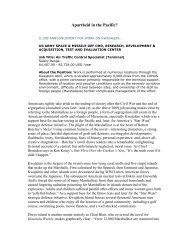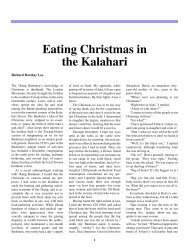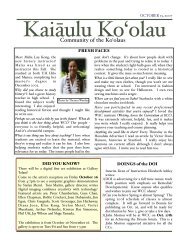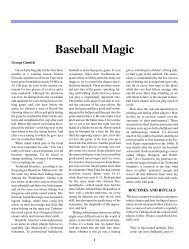Bundu Trap - Windward Community College
Bundu Trap - Windward Community College
Bundu Trap - Windward Community College
Create successful ePaper yourself
Turn your PDF publications into a flip-book with our unique Google optimized e-Paper software.
Asha Samad<br />
Worldwide, some 80 to 100 million women<br />
have undergone an operation first recorded in<br />
Egypt more than 4,000 years ago. Since then,<br />
“female circumcision” in various forms has<br />
been customary in many African and in some<br />
Asian, Middle Eastern, and indigenous Central<br />
and South American cultures. Very different<br />
from male circumcision (the removal<br />
of the foreskin of the penis), female circumcision<br />
can involve the partial or total removal of<br />
the clitoris and/or “infibulation,” surgical<br />
modification and suturing together of the labia.<br />
In some areas (Chad, Somalia, Sudan),<br />
“decircumcisions” are necessary to open infibulations<br />
before marriage and childbirth.<br />
While many associate female circumcision<br />
with Muslim tradition, it predates Judaism,<br />
Christianity, and Islam. It has also been practiced<br />
by Jewish communities and Christians<br />
living in regions where circumcision is customary.<br />
Condemned by African women’s groups<br />
and the World Health Organization as abusive<br />
and often dangerous, female circumcision<br />
persists even where modern African<br />
governments seek to limit or prohibit it.<br />
While most women survive these mutilating<br />
operations, they may suffer immediate and<br />
lasting physical effects. Hemorrhaging, infection,<br />
and infertility are among the serious<br />
complications. The inability to pass urine normally,<br />
pain during sexual intercourse, and excessively<br />
difficult deliveries are common<br />
results. Although harder to measure, emotional<br />
and psychological effects may also ensue.<br />
“You were standing there like a dead<br />
body. She was going to bring you home.”<br />
“I know my way home,” I answer defensively.<br />
“You know your way home, and you<br />
couldn’t keep a tray of food on your<br />
head.”<br />
“I told you I was afraid they were going<br />
to catch me.”<br />
The way Mother is looking at me, I<br />
know that if a garbage truck for children<br />
came along at this moment, she would<br />
happily throw me in.<br />
“They should have just circumcised<br />
you then so you could stay there. Maybe<br />
they’ll find you a husband after that.<br />
You’re no use to me.”<br />
I know my mother is just upset, so I<br />
don’t say anything. I go inside the house<br />
Afterword<br />
All groups circumcising females also circumcise<br />
males. Such groups regard the rite as<br />
an essential part of a child’s socialization.<br />
The operation is done at different ages in different<br />
societies—ranging from a few days after<br />
birth until puberty. However, among some<br />
ethnic groups it is done just prior to marriage,<br />
or, as in Rivers state, Nigeria, in the seventh<br />
month of the woman’s first pregnancy. The<br />
rite can symbolize the stability of the group as<br />
expressed in the faithfulness of its females—<br />
the passers-on of its customs and the maintainers<br />
of its families. The custom also reinforces<br />
respect and authority. The day of<br />
circumcision thus involves not only pain but<br />
also recognition for having become a full<br />
adult and a marriageable member of society.<br />
Other obvious functions of female circumcision<br />
include control of female sexuality and<br />
marital chastity. In patrilineal societies, authority<br />
over the bride is transferred at marriage<br />
to the spouse’s patriline. The bride’s<br />
moral and economic value to her patriline and<br />
to her spouse is dependent upon her unquestioned<br />
virginity as demonstrated by the intact<br />
infibulation.<br />
Many groups feel that attempts to prevent<br />
them from practicing circumcision represent<br />
an attack on their cultural integrity by “colonial,”<br />
Western interests and westernized African<br />
governments. (The Masai, for instance,<br />
are loath to change customs at the behest of a<br />
government that has moved them out of their<br />
traditional lands.) They may fear that loss of<br />
a cohesive tradition, with nothing to replace<br />
it, will result in daughters who are as “loose”<br />
and change my clothes, happy I came<br />
back—at least for now.<br />
NOTES<br />
1. Circumcision; secret society of circumcised<br />
women.<br />
2. Rice porridge.<br />
3. Sisal leaves cooked in West African<br />
sauce.<br />
4. Senegal-style red rice.<br />
5. Cooked cassava dough.<br />
6. Title of honor for a woman who has<br />
been on a pilgrimage to Mecca.<br />
7. A minority tribe of Sierra Leone.<br />
8. “Amen.”<br />
9. “Thanks be to God.”<br />
10. A majority tribe in Sierra Leone.<br />
11. “She sounds like a fishwife.”<br />
12. A shaman who will cast out “bad<br />
spirits.”<br />
Reprinted with permission from Natural History, August 1996, pp. 42–52. © 1996 by Memuna M. Sillah.<br />
6<br />
Article 27. <strong>Bundu</strong> <strong>Trap</strong><br />
as uncircumcised African and Western<br />
women are perceived to be. More generally,<br />
they believe that an uncircumcised daughter<br />
may become centered on herself, rather than<br />
family, home, and group.<br />
Some westernized Africans now debate<br />
the value of female circumcision. But fear<br />
that uncircumcised daughters will not be acceptable<br />
as brides in their communities<br />
spurs many to perpetuate the custom. Some<br />
parents may seek modified forms of the operation<br />
for their daughters and may have the<br />
procedure performed in private clinics or at<br />
home under anesthesia and in antiseptic<br />
conditions.<br />
Some—usually Western-educated African<br />
women, often of independent means, or<br />
those living in the immigrant and refugee<br />
communities of Europe and North America—<br />
have fully rejected the procedure and are educating<br />
women about its deleterious effects<br />
and organizing to end the custom. At the same<br />
time, other women protest what they consider<br />
outside interference in the most intimate aspects<br />
of their culture. They ask why Western<br />
women—whose own culture often leads them<br />
to radically alter their appearance, even<br />
through surgery—are so intolerant of the<br />
practices of others.<br />
What African women on both sides of the<br />
issue resent most is being looked upon by the<br />
rest of the world as self-mutilating primitives.<br />
Even opponents of circumcision feel that<br />
women from the ethnic groups practicing this<br />
ancient custom should be the ones leading the<br />
fight to eradicate it.<br />
Born in Sierra Leone, Memuna M. Sillah<br />
grew up “in the midst of quiet, yet constant,<br />
revolts, especially by teenage girls, against<br />
the unnecessary pain caused by genital mutilation.”<br />
Sillah came to the United States eight<br />
years ago, after living in London, Paris, and<br />
Kingston, Jamaica. Now a graduate student<br />
in sociology at City <strong>College</strong> of the City University<br />
of New York (CUNY), she has been<br />
actively concerned with the problem of female<br />
genital mutilation since 1993, when she<br />
chose the topic for a term paper in Asha Samad’s<br />
course on violations of women’s<br />
rights. “I then learned,” Sillah writes, “how<br />
widespread the practice is in Africa and other<br />
parts of the world—and the drastic forms it<br />
can take. This knowledge awakened my old<br />
teenage passions against the practice.” Sillah<br />
is now at work on a novel about immigrant<br />
African women in the United States.














